
text and photos ©2007 by Scott W Clemens
Alba is always full of life. It’s a tourist town, in the best sense of the term — full of local color, interesting shops, tiny little restaurants that spill out onto the street, and a festival of one sort or another happening every other week, or so it seems. In May, 2007 I once again journeyed to the Alba Wines Exhibition to taste through the soon-to-be released Nebbiolos of Roero, Barbaresco and Barolo. It also coincided with the Alba Jazz festival. Walking down the cobblestoned pedestrian street of Via Emanuele one Sunday, I found myself window shopping the pasta, wine and truffle shops, while moving into and out of earshot of one band after another. As the music faded behind me, another tune would come wafting up the street ahead, the sound reverberating from the facing buildings. But it has its peaceful moments, too; at 1 PM everything shuts down for an hour or two.
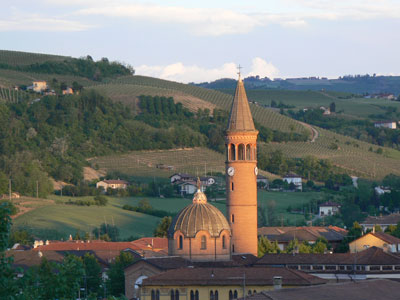
Round tower, sunset at Alba
Alba is the home of Italy’s oldest school of enology, established in 1888, and as the surrounding hillside vineyards attest, wine is at the heart of the commerce and culture of Alba. This is predominantly red wine country, though some very attractive indigenous whites are grown here, such as Arneis, Favorita, Timorasso. Just to the east of Alba you’ll also find Muscat for the still Moscato d’Asti and the much more famous Asti Spumante, grown in a zone that overlaps with the Barbaresco zone. Nevertheless, the area’s reputation is solidly staked on its reds grapes: Barbera, Dolcetto and Nebbiolo. Dolcetto is their everyday red wine. It can be boring, but occasionally surprises with its lushness. The Barbera is world-class, producing stunning wines that are rich in flavor and complexity, but never heavy because of their crisp acidity. It’s enjoyable when it’s young, and it can benefit from age. The Barbera here deserves more publicity than it receives, but in Piemonte it always plays second fiddle to Nebbiolo. Piemonte’s Nebbiolo is a hard wine to like in its youth, but it can age into magnificent maturity, developing a complex, yet delicate character. The Nebbiolo here can be divided into five types (from least expensive to most expensive, and presumably from least quality to best quality): Langhe Nebbiolo, Nebbiolo d’Alba, Roero, Barbaresco and Barolo — see sidebar for details.
| THE 5 TYPES OF NEBBIOLO WINE IN PIEDMONTAs in much of Europe, in Piedmont the wines often take their names from the towns around which they’re grown. Nebbiolo here is known as Langhe Nebbiolo, Nebbiolo d’Alba, Roero, Barbaresco and Barolo.LANGHE NEBBIOLO: Wines with this designation can be made from a broad area that includes all of the smaller zones, the wines need not be aged in cask, and the alcohol content must attain a minimum of only 11.5% alcohol. With the exception of a few iconoclasts like Gaja, who may label their best wines Langhe Nebbiolo out of a profound and perhaps perverse disregard for tradition, you can assume that the quality level will be uneven, and that the wine may in fact be declassified Roero, Barbaresco and Barolo that were not up to the standards imposed on those more illustrious designations.NEBBIOLO D’ALBA: In the guise of Nebbiolo d’Alba, Nebbiolo is grown in an extended area surrounding but outside of the Barolo and Barbaresco zones, from the hilly Roero area on the left side of the Tanaro river to the Langhe hills on the right. If it’s labeled Nebbiolo d’Alba it must have at least 12% alcohol, it doesn’t require oak ageing and can be released after a year of ageing. If it’s given an additional year of ageing it can be called riserva.ROERO: If it’s labeled Roero, it comes from the hills across the river from Alba. It must have at least 12.5% alcohol, it doesn’t require oak aging and must be released no sooner than July 1st of the second year after harvest. The riserva designation can be applied if the wine is given an extra year of ageing before release.BARBARESCO: For Barbaresco, the Nebbiolo must be grown in the hills to the east of Alba around the towns of Barbaresco, Neive and Treiso. Here the wine must be at least 12.5% alcohol and must be aged two years, with at least one year in cask. If it’s aged for four years it can be called riserva.BAROLO: As Barolo, the Nebbiolo must be grown in a delimited area south of Alba. It must attain at least 13% alcohol and must be aged at least three years, two of which must be in cask. If the wine is aged for at least five years before release, it can be labeled as riserva. |
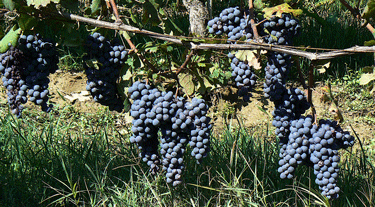
Nebbiolo in the Cannubi vineyard,
photo by Scott W. Clemens
It would be tempting to dismiss the different character of Roero, Barbaresco and Barolo as nothing more than variations in winemaking techniques, that Nebbiolo grown in the Roero would behave like Barolo if given the same aging regime. However, after tasting nearly 4,000 Piemontese Nebbiolos over the past ten years, I have to agree with the locals that the difference lies in the soil, which varies considerably from the Roero to Barbaresco to Barolo. I find Roero wines can have the same lush fruit and roses that one finds in Barolo, but Barolo develops far greater nuances and floral character with age, while Barbaresco displays a greater minerality. To my mind Roeros are greatly under appreciated and represent excellent value, especially from a good vintage. I think my colleague Kyle Phillips (see Kyle Phillips’s Italian Wine Review http://italianwinereview.blogspot.com) summed it up perfectly:
The terrains are sandier, and as a result tend to yield wines that have richer, more delicate bouquets, but are not as powerful as those from Barolo or Barbaresco. Within this framework there is of course considerable variation, and with respect to the other appellations there is perhaps more: Roero’s farmers have been making wine for just as long as anyone else in the region, but the appellation is much more recent than either Barolo or Barbaresco, and there is perhaps less consensus among the producers about what Roero should be: A wine that displays grace and finesse in a lighter key, or a more muscular wine?
Kyle was among the 50 journalists and 10 wine buyers who gathered in Alba in May, 2007 to taste the soon to be released 2004 Roeros, 2004 Barbarescos, 2003 Barolos and a few 2001 Barolo riservas. Some of the more famous producers declined to participate (producers like Gaja and Aldo Conterno, for instance). That’s understandable, for having gained a large reputation, they had more to lose by a poor showing, than to gain by a good one. Nonetheless, 182 producers did present 29 Roeros, 66 Barbarescos, and 202 Barolos in the formal blind tastings. In addition, we were afforded the opportunity to visit various wineries and participate in vertical tastings of older vintages.
With few exceptions 2004 Roeros and Barbarescos showed very well, a tribute to the vintage. 2003, on the other hand, was a very difficult vintage marked by excessive heat. Few producers were up to the task. The problems started in the vineyard and extended to the cellar; we found an unusual number (still under 5%) of spoiled wines that should not be on the market. The vast majority, however, simply showed the effects of raisined fruit — either cooked flavors or simply a lack of vibrancy.
The advantage of these blind tastings is that one cannot approach a wine with any preconceptions about the reputation of the producer; the wine has to stand on its own. For the purposes of these tastings (which took place over five days) we were given the vintage and the comune (township); for instance, we tasted all of the ’03 Barolos from Castiglione Falletto together, then those from La Morra etc. The fun came after the tasting when matching up the list to our notes. Many of the big names fell short, while a few of the smaller producers stepped into the limelight.
Marina Marcarino of Punset continued to show her mastery of Barbaresco. Giacosa Fratelli impressed with their consistency, once again producing solid Barbaresco and Barolo. Gianni Gagliardo and Elvio Cogno both showed some winemaking wizardry with their 2003 offerings. However, I was most impressed with Silvano Bolmida from Monforte d’Alba, who produced two excellent 2003 Barolos, as well as one of the best 2001 Riservas. His 2003 Barolo from the Bussia vineyard is a glaring example of why you can never write off an entire vintage; many other producers drawing fruit from the same vineyard ended up with cooked, out-of-balance wines, while Bolmida produced a wine to rival any vintage. The fact that his 2001 Bussia Riserva is equally good is testament to his consistency.
THE BEST 2004 ROERO
These wines are enjoyable now and will continue to evolve and improve over the next 5 years.
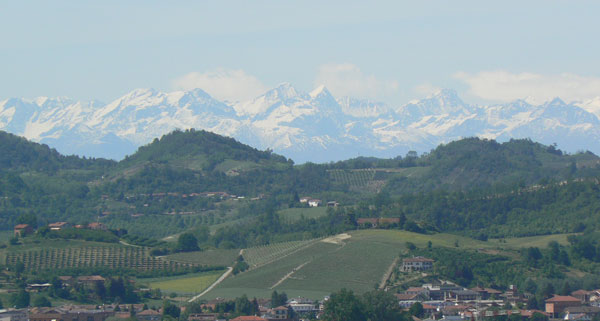
Roero hills and the maritime alps
CASCINA CHICCO, MONTESPINATO:
Ripe sweet cherry aroma, accented with a little vanilla, chocolate and a hint of earth. The fruit-oak-acid-tannin are all in perfect balance, the structure sublime, and the finish pleasantly fruity and spicy. This is a real stunner. 92
RENATO BUGANZA, BRIC PARADIS:
This is what Nebbiolo lovers can drink while they’re waiting for their Barolos to mature. It has the same tar and roses character as its big brother, with a hint of oak, but the tannins are soft, the acid crisp, the texture silky and the finish delightfully complex with interweaving fruit and mineral notes. It may even develop more nuances with age. 91
CASCINA CÁ ROSA, AUDINAGGIO:
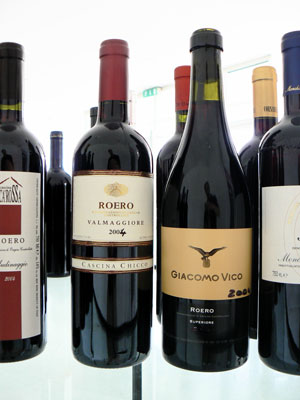
Bottles of Roero
Complete and correct, a Nebbiolo with refined balance and careful attention to detail. The varietal character is perfectly revealed in the sweet rose petal and cherry flavors, while a judicious use of oak adds just a touch of roundness and spice. The tannin is light, the finish bright and fruity. You could hardly ask for more. 91
GIACOMO VICO, ROERO SUPERIORE:
Rose petals and violets over licorice on the nose, tight structure, lots of minerality on the palate, with traces of truffles and tart cherries. A very creditable rendition. With the tannin in check it’s drinkable now, though it will improve with a few more years in the bottle. 90
GIOVANNI ALMONDO, BRIC VALDIANA:
You won’t mistake this for any other variety — it’s spot on: tar-roses-earth, with good acidity, moderate tannin and a dead leaf and mineral finish that lingers on for minutes. 90
MATTEO CORREGGIA, MOMPISSANO:
Attractive floral aromas with underlying earthiness and sweet oak, voluptuous on the palate, fat and floral, full of red rose-violet and tarry-earthy undertones. Excellent. 89
MALVIRÀ, TRINITÀ, ROERO SUPERIORE:
Light earthy nose, lovely rose-violet notes over cranberry on the palate, with crisp acidity, moderate tannin and a long, clean finish. Very attractive. 89
GIAN PAOLO VIGLIONE, BRIC AÛT:
Lots of cherry-berry fruit with earthy-truffle overtones, soft tannins, silky texture, and tart acidity. A bit angular and aggressive at the moment, it’s still a very solid Nebbiolo with perfect varietal definition, great for drinking now and for the next decade. 89
THE VERY BEST 2004 BARBARESCO
Presented by Comune (township)
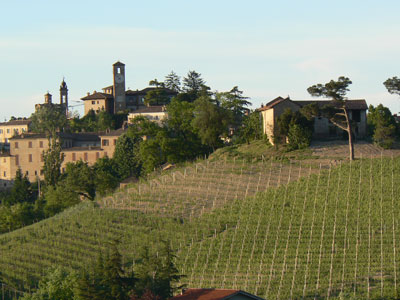
The town of Neive
Barbaresco from Neive:
SAN GIULIANO: A very beautiful rendition of Barbaresco, fine varietal definition with no one element overshadowing the next. It’s all here — the red roses, the minerality, the earthiness, a certain sweetness of fruit (even yellow peach) and a touch of spice on the finish. Hurrah! 93
PUNSET, CAMPO QUADRO: Lovely in every respect. It has a nose of cherries with floral notes, while the palate offers complex minerality, modest tannin and fine structure. It’s not flashy, just correct, and what more could you ask? 91
BONINO, SORÌ BASARIN: Intensely floral red rose, yellow peach, bright and vibrant, showing very little tannin. In many ways it’s not typical of Nebbiolo, but it is very attractive and complex, and altogether a very fine wine. 89
BATTAGLIO: This is a beautiful wine, perfectly integrated, vibrant and intense, displaying the rose petal and cherry character I expect from Barbaresco. Bright fruit, light tannins and a long mouthwatering finish make this a wine for current drinking, though you could age it another decade. 88
PAITIN: An old Romanesque church. Barbaresco with an evocative minerality, red berry fruit, modest tannins and a long minerally finish. Shows some finesse. 88
PUNSET: A beautifully made Barbaresco with a delicate balance of red fruit and minerals, modest tannin, well-behaved and understated, but oh so correct. 88
VIETTI, MASSERIA: A big, dense wine that speaks more of winemaking technique than terroir, but it will appeal to many with its huge floral bouquet, plummy fruit and forward oak tones. The chewy tannins will take several years to resolve. Don’t open before 2014. 88
GIACOSA FRATELLI: Stellar nose of ripe cherries with just a hint of earth underneath. On the palate it shows sweet fruit, moderate tannin, decent acidity and a mineral finish. A wine to drink now and age for another 7 to 10 years. 87
Barbaresco from Barbaresco
CASCINA BRUCIATA: Deep round nose of cherries and truffles, round and supple on entry with bright sweet fruit and a pleasant spicyness. The tannins are still present, but not obtrusive. Showing well now and it should develop well over the next decade. Best to open after 2010. 90
Barbaresco from Treiso:
LA GANGHIJA: You’ve got to love this nose; it’s full of red rose petals with just a hint of vanilla. On the palate the vanilla slightly dominates, along with hints of dark chocolate and spice. The oak teeters on the edge of stepping over the line, but at the moment it’s still in balance. The tannin is surprisingly soft. Drink now and for the next decade. 88
ORLANDO ABRIGO, VIGNA RONGALLO: Very ripe plummy fruit with the truffly character that betrays the varietal definition, lots spice and density on the palate, modest tannin and a short spicy finish. A decidedly masculine rendition. I preferred this to Abrigo’s oakier Vigna Montersina, though the latter will appeal to those who prefer a more international style. 88
LA SPINETTA, VIGNETO VALEIRANO: Here’s a Barbaresco that isn’t trying to hide it’s varietal (Nebbiolo) character under a lot of oak. It displays the red rose petals with a bit of licorice, while on the palate the acid is a bit aggressive, the fruit almost sweet on the palate. It’s angular and disjointed, but has all of the components to come together with a bit of age. Just look for the label with the Rhinoceros. 87
Barbaresco from Barbaresco:
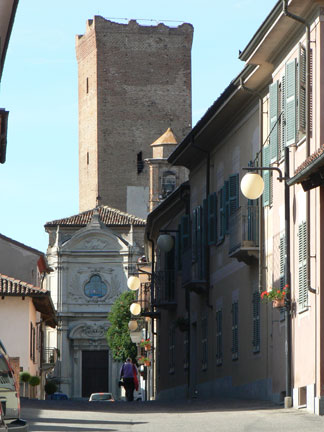
The tower of Barbaresco
ADA NADA, VALEIRANO: At first whiff you might think this a flashy wine with all of its artifice showing. It’s nonetheless complex and worthy of polite applause. The nose is wonderful, floral, fruity, and even a bit nutty, while the mid-palate displays sweet fruit and strong mineral overtones. Crisp acidity and strong mineral overtones carry the long finish. Ada Nada’s Cichin vineyard is also very good, but with a touch more acid. 87
PERTINACE, VIGNETO MARCARINI: A tart and correct Barbaresco showing the earthyness typical of Nebbiolo (an earthyness that is somehow different than Pinot Noir’s). This is a well-balanced wine with a bit of oak, crisp acidity, and minerally finish. Pertinace’s other Barbaresco, from the Nervo vineyard, is also decent, though less well integrated at the moment. 87
Few Notes on Recent Piedmont Vintages:
2004 Fairly large production, consistently fine for all varieties. Lush fruit in the early stages, but should also age well for 20 to 30 years.2003 This was a very difficult vintage due to the hottest summer on record. While there were a few superb wines made, many of the major players fell sadly short of expectations. Know your wine critic, or taste before buying.
2002 A disastrous vintage with lots of hail and rain. Many producers did not even try to produce a Barolo or Barbaresco. The few who did and succeeded should be applauded, but these are wines for early consumption, and they’re not particularly good values.
2001 An excellent year with fine structure. A bit lighter than the 2000s. Many of the Nebbiolo based wines will last for decades, though a few seem to be ageing prematurely. The same can be said for Barbera.
2000 A very good but warm vintage. The wines are progressing nicely, but without the depth of the ’96, ’98 and ‘99.
1999 Another very good vintage. The Barolos and Barbarescos are just beginning to open up.
1998 Big wines, but also wines with great vibrancy and nuance. Superb now and for the next decade.
1997 Everyone was excited by this vintage because it was one in which everything ripened perfectly and the wines were both concentrated and structured. As they’re ageing out the 1997s are perhaps less charming than the 1996s and 1998s, but they still have potential.
1996 The Barolos and Barbarescos are beautifully balanced wines that, 11 years after the vintage, are showing the delicacy and nuance that you always hope for and don’t always see.
1995 Well structured wines. The first of an unprecedented 7 fine vintages in a row.
THE BEST TEN 2003 BAROLO:
Presented by Comune (township)
Barolo from Monforte d’Alba:
SILVANO BOLMIDA, BUSSIA: Beautiful scent of red roses and vanilla; silky texture, fresh ripe cherry flavors with an underlying minerality that helps carry the finish. Absolutely lovely. Should be ready by 2010. 92
BARALE FRATELLI, BUSSIA: Heavenly rose scents; rich cherry-strawberry on the palate. Though the tannin needs about 4 more years to resolve, this will be a very nice Barolo if you’re patient. 89
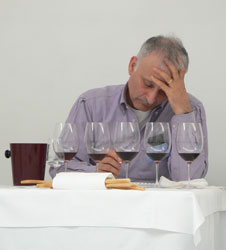
Master of Wine, Bill Nesto, contemplates the wines
SILVANO BOLMIDA, VIGNE DEI FANTINI: Very attractive nose with subtle layers of cherries and violets; full bodied and velvety, with ample tannins (don’t open until 2010), it comes across as sweet and ripe on the palate, and it has a slightly hot finish, but overall it’s a fairly attractive wine for the vintage. 87
Barolo from Castiglione Falletto:
GIACOSA FRATELLI, VIGNA MANDORLO: Good depth to the nose with layers of earth, minerals and fruit that follow through seamlessly to the palate. Long mineral finish. Good now despite the tannins, which should resolve by 2012. Excellent potential. 90
Barolo from Verduno:
ALESSANDRIA FRATELLI, MONVIGLIERO: Fine varietal definition with attractive floral notes, supple fruit on the palate and mineral notes through the finish. The tannin is still obtrusive, but should fall away by 2011 or so. 89
BEL COLLE, BOSCATO: Voluptuous nose, round and fruity, with a floral edge, medium bodied with fine minerality and decent fruit. The tannin will be resolved by 2009. It will probably not be the most complex of Barolos, but it should age gracefully. 88
Barolo from Serralunga d’Alba:
GABUTTI: Lush fruit, licorice, tar and roses, and loads of tannin. Don’t open until 2012 at the earliest, but expect to be pleasantly surprised. 89
BEL COLLE, BOSCATO: Voluptuous nose, round and fruity, with a floral edge, medium bodied with fine minerality and decent fruit. The tannin will be resolved by 2009. It will probably not be the most complex of Barolos, but it should age gracefully. 88
Barolo from Barolo:
GIANNI GAGLIARDO, CANNUBI: A refined rendition with a nice floral aroma (violets and lavender). On the palate it’s elegant, well balanced, showing fresh fruit red currant-strawberry fruit and a touch of spice. The sweet tannins are manageable and will smooth out by 2010. Good potential for further development. 88
Barolo from Novello:
ELVIO COGNO, RAVERA: Showing some decent varietal character in the nose, floral and soil notes; deep, rich fruit on the palate; still quite tannic but should develop nicely. 87
TOP TEN 2001 BAROLO RISERVA
Presented by Comune (township)
Barolo Riserva from Barolo:
VIRNA BORGOGNO, CANNUBI BOSCHIS: A big, complex wine that relies as much on oak as on its inherent fruit, and as such is atypical of Barolo. It’s fairly complex, with layers of jammy cherry fruit, oak spice and some lingering mineral notes through the warm finish. The tannin is just beginning to resolve and it should improve over the next five to 7 years. Giovanni Abrigo (see notes for Orlando Abrigo Barbaresco) also had a hand in making this wine. This 2001 has enough fruit to stand up to the oak. Their 2003 does not. 89
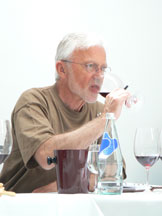
Jörgen Aldrich evaluates the Barolo
ENRICO BERGADANO, SARMASSA:
Mushrooms, cocoa and brown spices, silky smooth, lots of minerality and a hint of balsamic in the finish. The tannin is unobtrusive. Should continue to develop over the next decade. 88
GIOVANNI VIBERTI, LA VOLTA:
Though the tannin is still mouthpuckering, this is a serviceable Barolo with some complexity in its mushroom-dead leaf characteristics, as well as restrained dried fruit. Good now, and should continue to develop through 2015. 87
CASA MOLISSO, FOSSATI:
Still young and fresh, the tannin obscures the fruit, but enough comes through to show its quality. Nice truffles on the finish. 87
Barolo Riserva from Castiglione Falletto:
CAVALLOTTO FRATELLI, BRICCO BOSCHIS VIGNA SAN GIUSEPPE: Great nuance of fruit, flowers and earth, subtle spices, vibrant acidity. The curtain of tannin is beginning to draw aside. Enjoy now through 2015 and beyond. 92
GIANFRANCO BOVIO, BRICCO PARUSSI: Truffles and roses, mineral and spice, drying tannins, fine balance and extreme length. As the tannins further resolve you can expect nothing but improvement from here through 2015 and beyond. 90
Barolo Riserva from Monforte d’Alba:
SILVANO BOLMIDA, BUSSIA: Stellar, if understated, Barolo. Silky smooth, dried rose petals and dried cherry aromas and flavors, with the addition of fine minerality and a hint of truffles on the palate. Perfect balance. The finish is still a touch astringent, but with sweet notes, and it will improve as the tannins further resolve over the next three to 4 years. 91
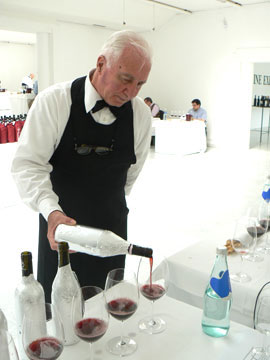
Sommelier Mario Cristino pours one of the 300 samples
Barolo Riserva from La Morra:
MONFALLETTO, GORETTE: A rather International Style Barolo, big and spicy, lacking nuance, but still plenty complex. Many will prefer this style, and it’s a well-made wine. With time it’s more feminine side may begin to show. 88
Barolo Riserva from Serralunga d’Alba:
ODDERO, VIGNA RIONDA: Spicy, crisp and lively. Full bodied, tar and old dried rose petals, soy. Silky, firm structure. Treading the line between youth and old age. Complex and interesting at this stage. 87
Barolo Riserva Blended from Various Comuni:
CASCINA ADELAIDE, PER ELEN: Lovely dried roses, dried cherries, dead leaf, lively minerality, firm structure, tannins resolving over the next 3 to 5 years. Well made. 90
